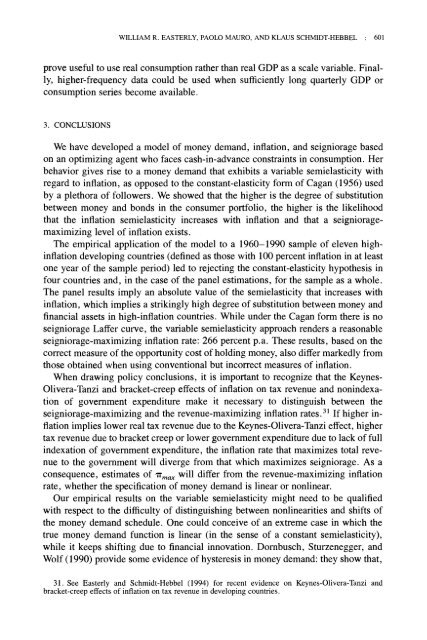Money Demand and Seigniorage-Maximizing ... - William Easterly
Money Demand and Seigniorage-Maximizing ... - William Easterly
Money Demand and Seigniorage-Maximizing ... - William Easterly
You also want an ePaper? Increase the reach of your titles
YUMPU automatically turns print PDFs into web optimized ePapers that Google loves.
WILLIAM R. EASTERLY, PAOLO MAURO, AND KLAUS SCHMIDT-HEBBEL : 601<br />
prove useful to use real consumption rather than real GDP as a scale variable. Final-<br />
ly, higher-frequency data could be used when sufficiently long quarterly GDP or<br />
consumption series become available.<br />
3. CONCLUSIONS<br />
We have developed a model of money dem<strong>and</strong>, inflation, <strong>and</strong> seigniorage based<br />
on an optimizing agent who faces cash-in-advance constraints in consumption. Her<br />
behavior gives rise to a money dem<strong>and</strong> that exhibits a variable semielasticity with<br />
regard to inflation, as opposed to the constant-elasticity form of Cagan (1956) used<br />
by a plethora of followers. We showed that the higher is the degree of substitution<br />
between money <strong>and</strong> bonds in the consumer portfolio, the higher is the likelihood<br />
that the inflation semielasticity increases with inflation <strong>and</strong> that a seignioragemaximizing<br />
level of inflation exists.<br />
The empirical application of the model to a 1960-1990 sample of eleven highinflation<br />
developing countries (defined as those with 100 percent inflation in at least<br />
one year of the sample period) led to rejecting the constant-elasticity hypothesis in<br />
four countries <strong>and</strong>, in the case of the panel estimations, for the sample as a whole.<br />
The panel results imply an absolute value of the semielasticity that increases with<br />
inflation, which implies a strikingly high degree of substitution between money <strong>and</strong><br />
financial assets in high-inflation countries. While under the Cagan form there is no<br />
seigniorage Laffer curve, the variable semielasticity approach renders a reasonable<br />
seigniorage-maximizing inflation rate: 266 percent p.a. These results, based on the<br />
correct measure of the opportunity cost of holding money, also differ markedly from<br />
those obtained when using conventional but incorrect measures of inflation.<br />
When drawing policy conclusions, it is important to recognize that the Keynes-<br />
Olivera-Tanzi <strong>and</strong> bracket-creep effects of inflation on tax revenue <strong>and</strong> nonindexation<br />
of government expenditure make it necessary to distinguish between the<br />
seigniorage-maximizing <strong>and</strong> the revenue-maximizing inflation rates.3l If higher inflation<br />
implies lower real tax revenue due to the Keynes-Olivera-Tanzi effect, higher<br />
tax revenue due to bracket creep or lower government expenditure due to lack of full<br />
indexation of government expenditure, the inflation rate that maximizes total revenue<br />
to the government will diverge from that which maximizes seigniorage. As a<br />
consequence, estimates of 1TmaX will differ from the revenue-maximizing inflation<br />
rate, whether the specification of money dem<strong>and</strong> is linear or nonlinear.<br />
Our empirical results on the variable semielasticity might need to be qualified<br />
with respect to the difficulty of distinguishing between nonlinearities <strong>and</strong> shifts of<br />
the money dem<strong>and</strong> schedule. One could conceive of an extreme case in which the<br />
true money dem<strong>and</strong> function is linear (in the sense of a constant semielasticity),<br />
while it keeps shifting due to financial innovation. Dornbusch, Sturzenegger, <strong>and</strong><br />
Wolf (1990) provide some evidence of hysteresis in money dem<strong>and</strong>: they show that,<br />
31. See <strong>Easterly</strong> <strong>and</strong> Schmidt-Hebbel (1994) for recent evidence on Keynes-Olivera-Tanzi <strong>and</strong><br />
bracket-creep effects of inflation on tax revenue in developing countries.


